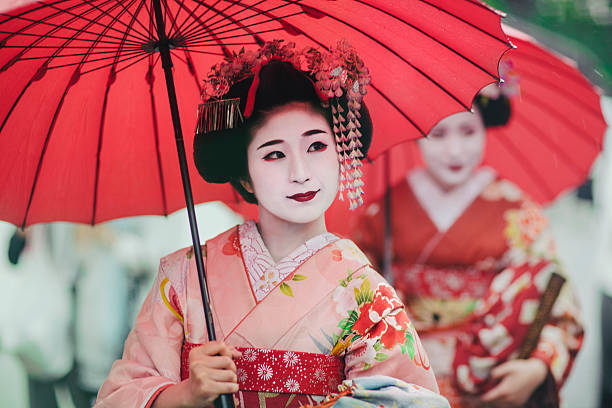Having touched upon bowing, removing shoes, and the ubiquitous “sumimasen,” let’s delve further into the fascinating tapestry of Japanese culture. For English speakers eager to understand the nuances of life in Japan, especially here in Tokyo, grasping these additional ten essential traditions will enrich your perspective and foster smoother interactions.

The Subtle Art of Silence (沈黙 – Chinmoku): Finding Meaning in Stillness
In many Western cultures, silence in a conversation can feel awkward or uncomfortable. However, in Japan, silence is often valued and can carry significant meaning. It might indicate thoughtful consideration, respect for the speaker, or even polite disagreement without direct confrontation. Don’t feel compelled to fill every pause in a conversation. Allow for moments of silence and try to interpret the unspoken cues. Sometimes, the most profound communication occurs without words.
The Importance of Saving Face (面子を保つ – Mentsu o Tamotsu): Avoiding Embarrassment
As mentioned earlier, “face” (mentsu) refers to one’s reputation, honor, and social standing. Causing someone to lose face, whether publicly or privately, is deeply avoided. This influences communication styles, where indirectness and tact are preferred over direct criticism. Be mindful of how your words and actions might affect someone’s social standing and strive to maintain harmony by being considerate and diplomatic.
The Culture of Apology (謝罪 – Shazai): Taking Responsibility
While “sumimasen” covers many situations, formal apologies (shazai) are a significant part of Japanese culture, especially in professional or more serious contexts. The depth and sincerity of an apology are crucial. You might witness formal apologies involving deep bows and specific phrases conveying remorse and a commitment to rectify the situation. Understanding the weight and different levels of apology is key to navigating social and professional interactions.
The Emphasis on Cleanliness (清潔 – Seiketsu): A Shared Responsibility
Cleanliness is highly valued in Japan and is a shared responsibility. You’ll notice the meticulous upkeep of public spaces, from spotless train stations to immaculately clean streets, even here in a bustling metropolis like Tokyo. This extends to personal hygiene and a general respect for shared environments. Be mindful of not littering and contributing to the overall cleanliness. You might even see people tidying up their own workspaces or small public areas.
The Queueing Culture (列 – Retsu): Order and Patience
Japanese people are generally very orderly and patient when it comes to queuing. Whether waiting for a train, bus, or at a popular restaurant, you’ll typically see well-formed lines. Cutting in line is considered extremely rude. Observe where the end of the queue is and patiently wait your turn. This reflects a collective respect for order and fairness.
The Etiquette of Eating and Drinking (食事のマナー – Shokuji no Manā): Beyond Chopsticks
While we discussed chopstick etiquette, Japanese dining involves other customs. It’s common to say “itadakimasu” (いただきます – I humbly receive) before eating and “gochisousama deshita” (ごちそうさまでした – Thank you for the meal) after finishing. Slurping noodles is generally acceptable and even considered a sign that you’re enjoying your meal. However, avoid talking loudly or placing your elbows on the table. Pouring drinks for others (especially superiors or elders) while ensuring your own glass is filled by someone else is also a common practice.
The Respect for Personal Space on Public Transport:
While Tokyo is a densely populated city, there’s a strong unspoken understanding of respecting personal space on public transport. People generally avoid loud conversations, eating or drinking (unless on long-distance trains), and making excessive noise. Even during rush hour, there’s a remarkable sense of order and consideration for fellow passengers. Being mindful of your volume and movements contributes to a more comfortable environment for everyone.
The Significance of Festivals (祭り – Matsuri) in Local Communities:
While we briefly touched on festivals, it’s important to understand their role in fostering community spirit and preserving local traditions. Throughout the year, you’ll find various matsuri celebrating everything from seasonal harvests to local deities. These events often involve vibrant parades, traditional music, and unique customs specific to the region or even a neighborhood within Tokyo, like those you might find celebrated in different parts of Shinagawa. Participating respectfully in these festivals offers a fantastic glimpse into the heart of Japanese culture.
The Concept of “Gaman” (我慢): Perseverance and Patience
“Gaman” is a cultural value that emphasizes perseverance, patience, and self-control in the face of adversity. It’s about enduring hardship without complaint and showing resilience. This concept is deeply rooted in Japanese history and can still be observed in various aspects of life, from dealing with daily challenges to overcoming larger obstacles.
The Blend of Tradition and Modernity:
Living in Tokyo, you’ll witness firsthand the fascinating coexistence of ancient traditions and cutting-edge technology. You might see someone in a traditional kimono walking past a sleek, modern building. This seamless blend is a defining characteristic of Japanese culture. While embracing modernity, Japan deeply values and preserves its historical and cultural heritage. Observing how these two seemingly contrasting aspects intertwine is a key to understanding contemporary Japan.
Continuing Your Cultural Exploration in Tokyo
These ten additional traditions offer further insight into the intricate and captivating world of Japanese culture. As you navigate life in Tokyo, or simply engage with Japanese culture from afar, keep these nuances in mind. By observing, learning, and showing respect for these customs, you’ll not only enhance your understanding but also foster more meaningful connections with the people and the rich heritage of Japan. Your journey of cultural discovery is an ongoing and rewarding one!
